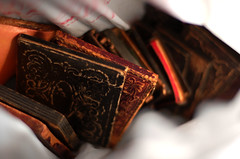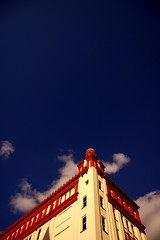Sunday, November 29, 2009
St. Augustine
This is a bit away from the Alameda (the original name of the great landscaped square that all three of the Flagler hotels face on.), on the old city square, this is the former First Nat'l Bank Building of 1928. Today, it's been re-dubbed the Wachovia Building. It's still, however, very much of its time. The shadow on the lower side of the building is the shadow of old Cathedral bell tower. I rather like the cream and the red contrastiness against the blue sky.
Thursday, November 26, 2009
Southern Snow
Happy Thanksgiving, everybody.
Wednesday, November 25, 2009
Daguerreotypography
Note: while I do know that the actual, correct term for the title is Daguerreotypy, I’m a real sucker for word bigness. So let’s just revel in the bigness of it all.
Since it HAS been well over a year since I last made a major entry in this blog (that would be classified under the category of ‘Oopsie,’) I thought I’d begin at the beginning. The beginning of photography, that is. Which I guess is natural, because I consider myself a photographer. And many consider the beginning of photography as being the Daguerreotype process.
My own personal love affair with the relics of photography’s first widely successful process began about four or five years ago, when I worked in an antique mall in Cocoa, Florida. I spent nearly a year there and loved pretty much every day of it. Anyone who knows me knows that nothing could make me happier than being able to spend a day combing through a bunch of old junk and non-junk, plus it was a way to be productive rather than just feeling like a slacker most of the day.
There’s something instantly recognizable about the Daguerreotypes (and Ambrotypes) of the mid-nineteenth century. And it’s not exactly something that a developed eye for things has to spot. Most Daguerreotypes and Ambrotypes, after their images were fixed to their plates and the photographic part of production complete, were placed in pressed leather or thermoplastic cases. Within the case, the image would be sealed in a pressed brass mount under glass. The protection of the image is two fold: Daguerreotypes had a silver-coated surface that is extremely sensitive to scratches and handling – and dings could probably damage the coating to the point of knocking some of it off. The cases provided protection against both of these: the soft pressed leather over scrap wood protected the plate from dings and dents, and the glass seal with their beautiful pressed brass mats protected the plate from handling: Fingerprints, scratches, etc.
It was these two attributes that I spotted and recognized instantly while working in the shop. A dealer had four or five cased images that I thought were Daguerreotypes. I was very, very much tempted by them, but I couldn’t afford buying them. Unfortunately, before I could pick them up, the dealer retired and moved out of the antique mall.
In retrospect, I didn’t realize that most of those cased images were actually Ambrotypes, images produced by a process that would come to replace Daguerreotypy by the late 1850s. I learned that lesson years later. It was actually this year that I learned it*.
In January I was in Melbourne, feeling tempted by nineteenth-century magic lanterns and old bell-pulls and a set of cast iron closet hooks. (Sounds less interesting than it actually is, a set of swiveling metal closet hooks that are mounted into bead-moulded slats that are part of the side of nineteenth century living that I adore, but no one hardly ever gets to see: the utilitarian side of nineteenth-century living.) Knowing I couldn’t afford all I desired (no one can, really. But isn’t there some sort of life lesson to be had there?) I walked into another antique place, and looked through the shelves.
A bowl, silver, was piled with odd square things that I didn’t recognize just by a glance and nearly missed beckoned my attention. I stopped, looked more closely, and found the bowl full of Daguerreotype case halves, all pressed leather and paper, all beat up and worn, empty of the silvery images that they once housed and protected. I started to look through them, and I didn’t see a price. I blurted out, after asking about the price on them, how much they wanted for the whole bowl of them. And after hearing “ten dollars,” I got all excited.
I stood at the desk, gushing internally. I kind of forgot the magic lantern (regrettably, I think, now) as I watched the lady at the desk pour the tattered leather squares into a “thank you thank you thank you” bag. I didn’t want the bowl and I wasn’t paying for it. I thought it was ugly, but its contents made me extremely, extremely pleased. I didn’t even wait to get back to the car with them before I started to ogle them. When I got to the other side of the street, I started sifting through the bag. Inside I found an odd piece of copper, that when I turned it over had an odd mirror-like surface that had no discernable image. I thought it was a mirror. On the way home, however, as I sat in the passenger's seat loving the patterns and motifs on the leather and paper surfaces of the cases (produced by a steam die-press, in a similar, if not identical process as the pressed brass mats that sit on top of the plate) I came across the little copper piece again. As I turned its silvery mirrored surface, an image leapt out at me off the surface, and I literally caught my breath, because I realized I was holding in my hands a true Daguerreotype, and my eyes were meeting the gaze of someone who had, a hundred and sixty years before, had sat in a stifling photo with her head clamped in a metal clamp for a good ten seconds as her image was imprinted on the silver surface of the copper plate, that now, after its extremely cruel and rough life, was now in my hands, presenting its tarnished, scratched and damaged surface to me without shame, or pretence.
I didn’t even wait to get back to the car with them before I started to ogle them. When I got to the other side of the street, I started sifting through the bag. Inside I found an odd piece of copper, that when I turned it over had an odd mirror-like surface that had no discernable image. I thought it was a mirror. On the way home, however, as I sat in the passenger's seat loving the patterns and motifs on the leather and paper surfaces of the cases (produced by a steam die-press, in a similar, if not identical process as the pressed brass mats that sit on top of the plate) I came across the little copper piece again. As I turned its silvery mirrored surface, an image leapt out at me off the surface, and I literally caught my breath, because I realized I was holding in my hands a true Daguerreotype, and my eyes were meeting the gaze of someone who had, a hundred and sixty years before, had sat in a stifling photo with her head clamped in a metal clamp for a good ten seconds as her image was imprinted on the silver surface of the copper plate, that now, after its extremely cruel and rough life, was now in my hands, presenting its tarnished, scratched and damaged surface to me without shame, or pretence.
I didn’t get excited because I thought the damaged plate was valuable. I don’t shop for antiques like that. I only look up values of certain items when I want to make sure that I WAS justified in spending the money that I did on certain things. It’s kind of a self-justifying, enabling thing. I despise the Antiques Roadshow with a passion.
I knew the image isn’t valuable. Not just because of its damage, but because of the commonness of its image. Tens of thousands of young ladies went to get their daguerreotype likeness taken (advertised by some Daguerreotypists as paintings by the sun.) in their best dresses. Unless the dress is particularly fancy, or they happened to have not removed their bonnet in the studio (perhaps wanting to show it off to her friends, or wanting to preserve an image of herself in a favorite bonnet, as a bit of justifiable feminine vanity) or are carrying something remarkable, the image isn’t worth much. The Daguerrean expert who I e-mailed about my beat up Daguerreotype even told me the image wasn’t really worth restoring and resealing, because the cost of restoring and resealing the plate would far exceed its value.
But all the money mumbo-jumbo doesn’t matter to me. It’s my first Daguerreotype, and I love it. I have a thermoplastic “Union” case that had an empty brass mat and glass in it, that fit the Daguerreotype, so I matted it up and popped into one of the pressed leather case-halves that I bought that day. Just because I could. And because I like it. Because Daguerreotypes are kind of cool like that.
*This lesson, lest I forget to mention it, is that Daguerreotypes are typically on a copper plate have a mirror like surface, upon which the photographic image will usually only be seen once you look at it at about a fifteen-to-thirty degree angle. Ambrotypes are typically on glass, and do not have that mirror-like surface, their images are immediately visible upon opening up the cases in which they’re housed. They do, however, posses their own special qualities which I’ll write about later.
Tuesday, November 24, 2009
So, uhhh... it's been a year and two days everyone.
Heh. Yeah, I kind of let this slip.
But I've been thinking lately of kicking it around again. And hopefully, not letting it sit for another year untouched.
Because that's kind of bad.
Really, it is.



